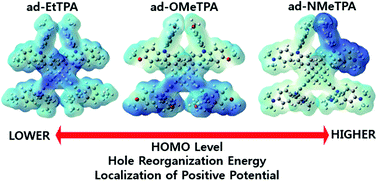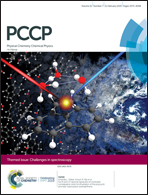Novel adamantane-based hole transport materials for perovskite solar cells: a computational approach†
Abstract
Adamantane derivatives have been subjected to quantum mechanical calculations to determine their capabilities as potential hole transport materials (HTMs) in perovskite solar cells (PSCs). Adamantane has been modified in two ways: multiple arm substitution and outermost substituent variation. It has been shown that tetra-substitution of adamantane gave the best characteristics as a HTM. Further modification showed tetra-ethyl substituted adamantane (ad-EtTPA) has the lowest HOMO, a small hole reorganization energy (λh), absorption in the UV region, and good stability. These appropriate properties mean that ad-EtTPA could be a promising HTM in PSCs. In addition, the relationship between λh and the electrostatic potential (ESP) maps of the cationic geometry has been studied. Three outcomes were drawn from the investigation: (1) the high positive potential in the ESP map is the region where more geometric distortions are occurring in going from the neutral to the cationic state, (2) large geometric distortions in this region lead to high λh, and (3) for tetra-substituted adamantane derivatives, delocalization of the positive potential leads to lower λh. The results showed that ESP maps can give insight into the molecular engineering of HTMs.



 Please wait while we load your content...
Please wait while we load your content...